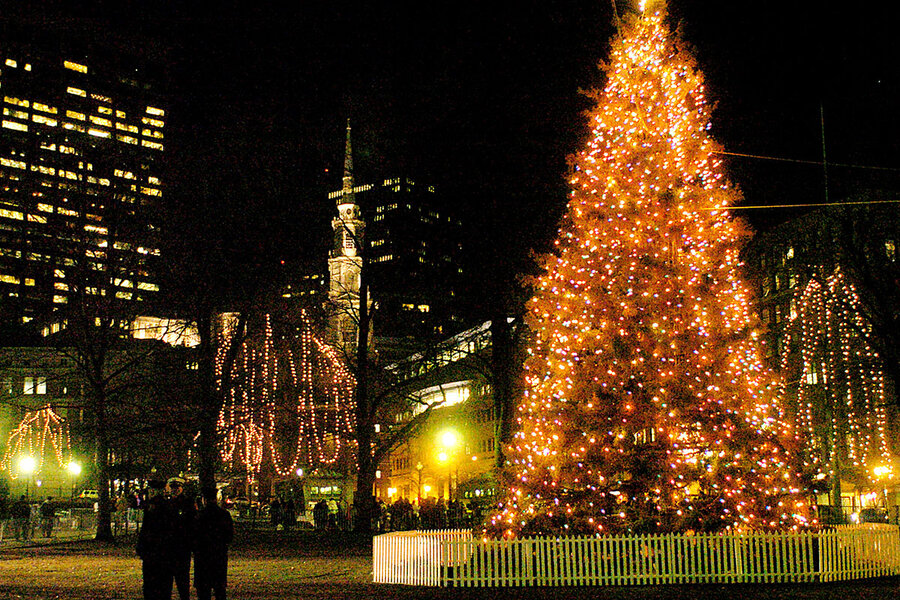In Boston, a Christmas tree symbolizes a cross-border friendship
Loading...
Every November, as thousands of Bostonians gather at the city’s annual Christmas tree lighting ceremony, they pay homage to a giant spruce shipped from Nova Scotia to Boston Common. At first glance, this year was no different. Under a shower of confetti snowflakes, the crowd sang a rousing chorus of Christmas carols as Santa arrived on stage to help Mayor Marty Walsh officially ring in the holiday season.
Massachusetts has plenty of strong, tall pines growing in its own forests. So why does its capital feature a Canadian behemoth? Simply put, it is a Christmas present. And this year’s 53-foot-tall holiday centerpiece not only brightens the landscape, it shines a sparkly light on a century of friendship between Boston and Halifax, Nova Scotia, which sprung from a call for help, and helped solidify a once-faltering international alliance.
“It costs [Nova Scotia] $180,000 to do this every year,” says John Bacon, author of “The Great Halifax Explosion: A World War I Story of Treachery, Tragedy, and Extraordinary Heroism.” “They identify the best Christmas tree in the province, often on private property. The owner donates it proudly,” and there is even a tree-cutting ceremony.
The origins of the gift
But why does Boston deserve such an expensive, yearly gift?
On Dec. 6, 1917, two ships collided in the narrows just outside Halifax Harbor. One, the Mont Blanc, was loaded with explosives. The ship caught fire and triggered the worst man-made explosion ever witnessed before the atomic bomb. The force instantly flattened 12,000 buildings, eventually killing some 2,000 people and injuring hundreds more. Soon a heavy snow began to fall with gale force winds.
Massachusetts governor Samuel McCall, who received word of the disaster an hour after the explosion, immediately dispatched a team of first responders. They traveled by train through a blizzard to aid the survivors, blasting their way through 15-foot high snow drifts, arriving even before the trains sent by Toronto and Montreal, recounts Mr. Bacon.
More trains followed in the coming days carrying medical supplies, doctors, and nurses, many of whom stayed through the holiday season to assist with the recovery process.
The third train to arrive in Halifax was funded and dispatched by The First Church of Christ, Scientist, in Boston (the publisher of the Monitor). Church members gathered supplies, warm clothing, and other donations to fill a train sent from Bangor to Halifax, says Judy Huenneke, a senior research archivist with the Mary Baker Eddy Library. The church-sponsored train also carried doctors, nurses, and reporters who were all trying to reach Halifax to give aid and spread word of the disaster.
The recovery efforts launched by Boston quickly spread to include assistance from US cities such as Chicago, St. Louis, and New York, bringing much-needed supplies and nearly $25 million in donations to Halifax.
“Boston’s help inspired the rest of the United States to help,” says Bacon.
Melting animosity
The significance of this friendship extends beyond the two cities, notes Bacon. Since the founding of the US and Canada, relations were sometimes fraught with conflict, and tensions at the time were high. Just a few years earlier in 1911, some in the US Congress talked of annexing Canada, and controversy over trade policy fanned anti-Americanism north of the border. But the immediate response from Boston to the tragedy in Halifax broke down the animosity between the two nations and sparked one of the strongest alliances and trading partnerships in US history.
The citizens of Halifax have never forgotten.
“When the trains finally showed up, going through a blizzard that night, the Canadians, the people in Halifax started crying…. [T]hey could not believe they’d gotten there so fast. They couldn’t believe that it was Boston. Not Montreal or Toronto who got there first,” says Bacon.
The following Christmas, in 1918, as a thank you gift, the province of Nova Scotia sent a Christmas tree to Boston, which was proudly displayed on the Common for all to see.
But it wasn’t a one-time gift. The symbol of thanks and brotherhood was revived in 1971, and has continued every year since.
This year’s special anniversary was dedicated to first responders, both those who served during the Halifax explosion and those who continue to serve in their communities today.
“We will never forget the support the people of Boston and the surrounding area provided,” Nova Scotia Premier Stephen McNeil told the crowd at this year’s tree lighting on Nov. 30. “As a thank you, and to mark our ongoing friendship, we are very pleased once again to give the gift of a beautiful Nova Scotia Christmas tree and celebrate the season in your city.”
Editor's note: Accounts of the number of people injured in the Halifax explosion vary, but this story has been updated to conservatively say that it’s hundreds.









